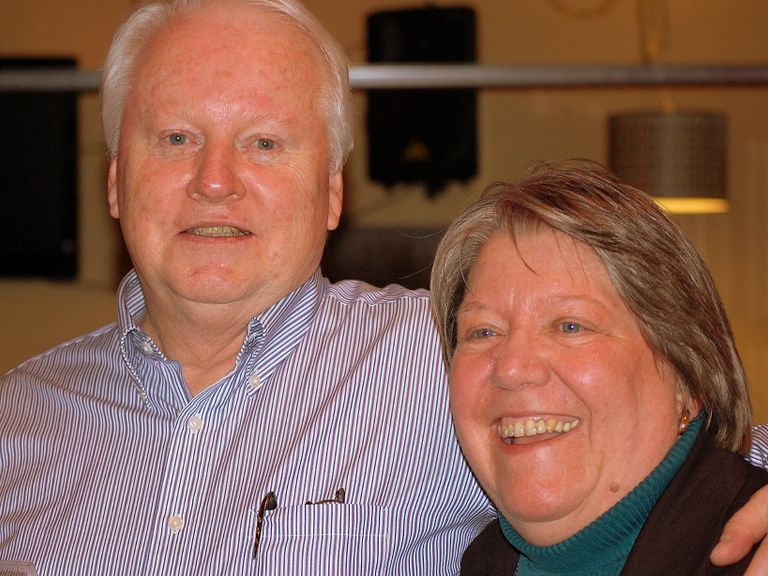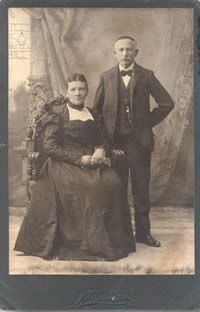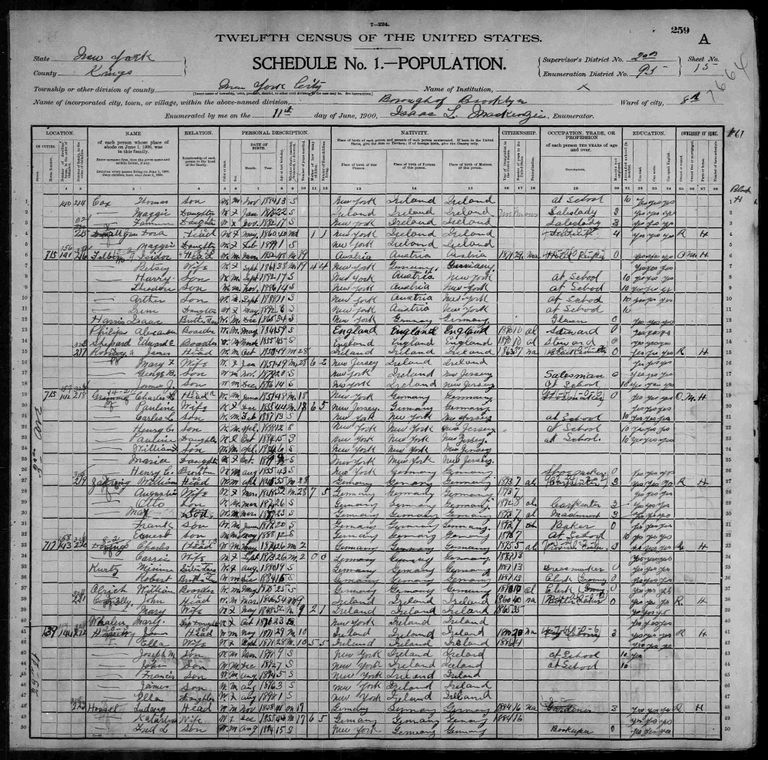
The Zaehrings of Friday Harbor
Our present generation
The current generation of Zaehrings started in New Monmouth, New Jersey with the marriage of Dan Zaehring and Andrea Atkinson on June 10, 1967. Since then the family location has moved from New Jersey to Illinois- Wisconsin, then to Hawaii and finally to San Juan Island in the Salish Sea in Washington State. The next generation was born while in Hawaii and eventually produced an additional generation in Washington State.
The backstory of the website is a curious quest for all Zaehrings in the United States and whether they were all related. As the internet evolved, more and more Zaehrings were tracked and linked to a single family of seven who arrived in New York from Eastern Germany in 1893-4. This resulted in the story of the Zaehrings in America.
As family tree documentation has become more abundant online, more family connections were made. Eventually information about the family in East Prussia has emerged.

The Zaehring Story in America
Introduction
In beginning a family history, it must be acknowledged that family history is so much more than facts and dates. It is the whole environment into which each family member comes, a combination of genes and personalities interacting with situations perhaps unique in history.
What made a Prussian family with five children emigrate from a place which was familiar to a foreign land across the sea? What impact does living near the harbor in Brooklyn as immigrants play on who they saw themselves to be?
The first generation born in this country spent childhood in New Jersey amidst a country at war with the “old country” and animosity in the neighborhood. Having rocks hurled at young school age children for being “German” has significance in understanding who they grew up to be. Maturing during a decade long depression, which resulted in both economic depression as well as personal depression, also had life-long effects.
As we uncover these external facts, it at least leads us to speculate as to the personalities and make-up of those who were responsible for shaping our parent’s – and even our own – lives. All of our ancestors were imperfect people with their own faults and foibles– not a lot different than we are today. But a generation ago family didn’t talk about such things much, so we were left to wonder about unexplainable behaviors.
We all carry with us the baggage of what has gone before. In understanding some of it, perhaps we can come to peace with it and use it to make each of us stronger for having known.
The First Generation
The story of the Zaehring’s in America begins sometime in early 1893 with a family’s decision to emigrate. The father was Wilhelm Zaehring (Zähring), born April 22, 1845. The mother, Auguste was born Auguste Emilie Reichow on October 8, 1847. Her parents, August Reichow and Auguste Emilie Bordt, were married in Pomerania, but coming from two different parishes. Wilhelm’s parents appear to be Gottlieb Zähring and Wilhelmina Preusz.
They were married in 1872 (according to William’s declaration on the 1900 census). Their children were Otto, born on March 23,1873, Margaret, born on September 29, 1875, Max, born on March 27, 1877, Franz, born in June 1879, and Ernst, born on May 12, 1888. Family members also recount a “Helena” as a sixth child who may have died at birth since there is no other known record. (The 1900 census indicates five of seven children were living.) There is not much information yet about the family’s roots and movements. Some family stories say the couple was married in Berlin, but that is unlikely. The family lived in Memel, East Prussia (now Kleipeda, Lithuania) for a number of years prior to emigrating to America. The birth record for Max in Memel has been verified. Otto and Ernest both filed documents that they were born in Memel. Ernst (nka Ernest) registered with his draft board stating that he was born in Memel (He spelled it Memmel). Memel has a long history of German connections. It was originally captured by crusading Germanic knights of the Livonian Order who built Memelburg, a wooden castle at the mouth of the Dane River in 1252. When Napoleon captured Berlin in his conquest of Europe, Kaiser Frederick Wilhelm III fled from Berlin to Memel, where his household remained until after Napoleon was effectively defeated outside Moscow.
When Wilhelm and Auguste were born, there was no unified country known as Germany. Kaiser Wilhelm I, through the able and ruthless assistance of Otto von Bismarck, completed the unification of Prussia into one country in 1871. In the mid 1870's, about the time Wilhelm and Auguste were married, an economic depression hit much of Germany, causing much hardship, particularly among shopkeepers and tradesmen. With the name Zaehring, Wilhelm’s ancestors possibly originated from the southwestern part of Germany where various cities were built by Zähringers, such as Berne and Freiburg. There are numerous interesting legends surrounding the Zähringers, many fictitiously linking them to Barons and Dukes of the twelfth and thirteenth century. There are family stories that Otto remembered playing at a castle that had his name, which has led some of the family to suggest that perhaps the family either resided there for a time or paid relatives there an extended visit. Be that as it may, the 1920 census has Max declaring that not only was he born in East Prussia but so were both of his parents. In Germany today, “Zähring” and “Zaehring” are not uncommon names. The “Zaehring” spelling was prominent in northern Germany (Prussia) while the umlaut spelling seems more frequent in the south. Auguste signed her name on Max’s birth record as “Zaehring”. During the time their children were growing up, Prussia had mandatory schooling from age 7 to 14, so the family had at least basic education.
There is a family recollection that while the family was in Memel, East Prussia, Wilhelm– either alone or with part or all of the family– went to Russia to pursue work. Memel is right on the Russian border. Many workers from Memel went into the Russian forests nearby for timber. Alternatively, perhaps this is what got them to Memel in the first place. During this period there was a steady stream of emigration which reached a torrent from Russia, Prussia and numerous other European areas. The vast majority of emigrants were leaving a destitute existence, while some were fleeing religious persecution. The Zaehring family, being Protestant Lutheran, would not have experienced religious persecution directly, except perhaps in Russia–if any of the family indeed went to Russia. Catholics and Protestants alike were severely discriminated against there, although nowhere near that experienced by the Jews in European Russia.
Whatever the reason to emigrate, the decision resulted in Otto, the oldest son, making his way to Rotterdam where he was able to board the ship S.S. Edam bound for America. He arrived on May 2, 1893 at Ellis Island, New York. Soon afterward, perhaps after receiving word of Otto’s safe arrival, Wilhelm set out with his second son, Max, age 15, from Bremen aboard the S. S. Saale. They arrived on July 11, 1893 at Ellis Island and began the process of finding work and adequate quarters. Finally, on October 6, 1894, over a year later, Auguste, his wife, their daughter Margaret and their two youngest sons Franz and Ernst arrived at Ellis Island from Hamburg. Emigrants in Hamburg while facing delays until they could embark were sheltered in large dormitory-like buildings down by the docks. With a stopover at Southampton, England, they voyaged for nine days aboard the S. S. Columbia. The Zaehring’s all came third class– otherwise referred to as steerage. (or “Zwischendeck”.) This consisted of large open rooms with numerous beds arranged for the many passengers. Thus the family was reunited in America.
Upon arrival,Wilhelm changed “Wilhelm” to “William” and upon their arrival changed “Franz” to “Frank” and “Ernst” to “Ernest”.
By the time of the 1900 census, the family was renting their home at 715 3rd Avenue in Brooklyn, Kings County, New York. The census lists William and Otto as carpenters, Max as a machinist, Franz (now known as Frank) as a baker and Ernst (now known as Ernest) as at school. Auguste’s occupation didn’t warrant the census taker’s mention. Margaret was no longer home, having already married John Frederick Belus, but lived nearby at 229 22nd St. The parents had a portrait (pictured) taken in a Brooklyn photographer’s studio about this time– probably three years previously on their twenty-fifth wedding anniversary. After moving to Newark, New Jersey, William died in 1912. Auguste was listed in the 1913 City directory as a widow. Auguste lived with her son Otto and also with several other of her children. She died around 1926.


The Next Generation
Otto
By 1910, Otto, William and Auguste’s first child, was living at 172 Hillside Ave in the southern part of Newark, NJ with his parents. Sometime after his father’s death he and his mother, Auguste, moved to a house he built himself on Wesley Place in North Arlington. At some point, he suffered a severe case of frostbite on his ears while working outdoors, making the cold New Jersey winters quite painful. For this reason he went south each winter to Florida where he worked until spring before returning to his home in New Jersey. His winter home in Palm Beach County, Florida was a small house on a small farm about five miles inland from the ocean where he grew, among other things, potatoes. Each time he came north in his Model T Ford, he brought citrus fruit for the family. One year his nephews chipped in to buy a Model A car since his Model T was worn out. But when it was time to go south to Florida he sold it and bought another Model T, apparently unable to get comfortable with a standard stick shift. (Model T’s essentially had just a “forward” and “reverse”.) He would make these trips in about three days which, considering he was in a Model T on 1930s roads, is really “pushing it.” He remained single his entire life. He died April 15, 1945 in Palm Beach County, FL. To quote his nephew, “He was a very good man.”
Margaret
Margaret, William and Auguste’s second child, married John Frederick Belus between 1895-97, who was himself no stranger to immigrant problems, having come to this country from Germany as a young teenager in 1880. They had three children, Eleanor, born August 24,1898, William Charles, born September 29,1901 and John Frederick Belus, Jr. born May 31,1906. By 1910 they too had moved from Brooklyn to 194 Devon Street, Kearney, NJ, where John, Sr. worked as a machinist at the pump works nearby. Margaret died about 1925. One anecdotal fact in family memories is that Margaret served as a governess for the Adams family, of Adams chewing gum fame.
Max
Carl Emil Max, William and Auguste’s third child, married Elsie Weise, born November 22, 1882, in 1909 . William hand-made a round mahogany table with two matching padded chairs as a wedding present. After living briefly in Brooklyn, they moved to the bottom floor of a tall but narrow multifamily house on the corner of Bergen and Highland Ave (105 Bergen Ave), Kearney, NJ, on top of the ridge overlooking the Passaic River several blocks away. Max was a machinist at the pump works (perhaps together with John Belus, Sr.). They had three sons there, Robert William Zaehring born February 19, 1912, Rudolph Otto Max Zaehring born September 21, 1914 and Bernard Carl Zaehring born May 4, 1916. They moved to Princeton Ave, Scotch Plains in 1921. In the 1930s, Max grew gigantic strawberries, which he sold from a stand down on the main street. Max died March 17, 1944. Afterward, the family built Elsie a tiny cottage next door where she lived alone for many years, supporting herself as a housekeeper to a number of families who remembered her fondly. She carefully tended gardens all around her little cottage in what was Plainfield, then Scotch Plains and subsequently part of Westfield, New Jersey. Elsie died in 1982. The cottage remains almost the same as originally built, but without Elsie’s bountiful garden. Their sons lived for many years in New Jersey and eastern Pennsylvania, although all three ended up in Florida.
Franz (Frank)
Frank, William and Auguste’s fourth child, married Nellie Sherman, daughter of George and Hannah Forrest Holman. They had a daughter, Arriadna born November 15, 1905. The 1900 census and a 1909 city directory reported his occupation as a baker. Frank died before 1910. (Interestingly the 1910 census shows Auguste having 5 children with 4 living.) By 1920, Nellie and Arriadna had moved to Alameda, CA to live with Nellie’s sister, Grace Sherman, who ran a boardinghouse there. Nellie is listed in the 1920 census as Nellie Bowers, a widow. According to her sister’s family she remarried a Mr Rollins (or Robins) in California. Arriadna married Joel Carr and had one daughter, Doris Mae Carr. Arriadna married Mr Swan by the time of her death on September 24, 1960 in Alameda County, CA. Her daughter, then referred to as Mrs Doris Clark, had several children. I have not found any more information about this branch of the family.
Ernst (Ernest)
Ernest, William and Auguste’s fifth child, was a private in the Marines, having enlisted in 1908 at the Brooklyn Navy Yard. He was stationed in the Philippines at the time of the 1910 census. He also served in Guam, Shanghai and Boston. He subsequently married Helen Raichel and had one child, William Ernest, born in 1916. They lived in Arlington, NJ before moving to Bristol, PA. Ernest died in 1944.